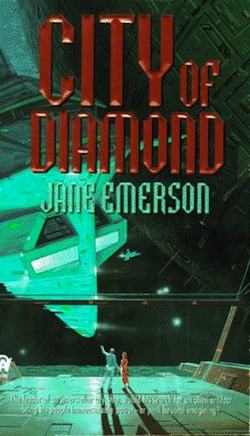What Jane Emerson (who also writes as Doris Egan) is creating is worlds that have history and complexity and depth, coming up with characters that couldn’t possibly come from any other background, and then having fun with them. When I wrote about the Ivory books, I said it was hard to explain what made them such fun, and I have the same problem with City of Diamond. I can talk about the wonderful future world at great length, and I could gossip about the characters all day, but when it comes to explaining what makes the book so great it’s almost impossible. It’s more than a week since I finished City of Diamond, and I haven’t been writing about it because I keep thinking I’ll find a way of conveying the joy of it.
I first read it because Kate Nepveu gave me a copy and said “Read it, you’ll like it.” She was right. It’s space opera, it’s a big thick book, and it makes me smile whenever I think of it.
So there are thousands of settled planets, arranged in sectors, with instant travel gates between sectors and FTL travel within sectors—except that there are also three ships the size of huge cities that travel by a completely different system of FTL that was given to them a long time ago by some mysterious aliens called Curiosa. These Cities are inhabited by religious fanatics who practice “blood Christianity” in which they have merged Christianity with the Curiosa religion to come up with something very strange indeed. They have very odd ideas about medicine, for instance.
A beautiful girl from the City of Opal is marrying the Protector of the City of Diamond, and this is an occasion of much intrigue and positioning and plotting. Both of them are point of view characters. We also spend quite a bit of time in the head of one of the girl’s bodyguards, who comes from a low level Francophone slum on Opal. There’s also Spider, who was saved from death at the last minute by Tal, who is an alien, or half an alien—there are aliens called Elaph, and they’re interfertile with humans, but the children are inevitably psychopaths. Tal’s a psycopath, and on Diamond they call him a demon, but he’s a very interesting character. He acquires a Greykin bodyguard—Greykin have their own planet and very interesting culture. And I love them all, they’re all terrific POV characters.
And the Cities of Diamond and Pearl have just come to a new planet where they want to trade, and where they suspect there may be a Curiosa relic.
There’s a way when you tell a story where you, the author, decide on what key to tell it in. Everything I’ve said here about it could be told in any key, from very dark to lightest froth. What’s hard to explain is the key in which Emerson tells this story, and it’s that which is so unusual and so difficult to compare to anything else. She takes it absolutely seriously, but it’s still a comedy in the Shakespearean sense; you know everything will come out all right. And it’s very funny. Usually when something is humorous, there’s a level on which it also isn’t real, where the author is poking fun, where you’re not supposed to care, because the laughter breaks tension in a way that prevents it. Emerson doesn’t do that at all, the reality is absolutely solid, the consequences for the characters are potentially devastating, and you are supposed to care. The humour is internal and arises out of the characters and situations, but it is funny. There’s some wonderful dialogue that makes me laugh out loud. Everything fits together perfectly with inevitability arising from who the characters are, in the worlds that formed them, and it earns its happy ending.
If I did compare this to anything, it would be Cherryh’s complexity of worldbuilding, Banks’s scale, and Bujold’s characters driven by their unique backgrounds. Thinking about these comparisons, though, leads me to the thing that’s wrong with City of Diamond; although it had plot and characters and world and they’re all great, it doesn’t have ideas. It’s just a story—a very good story, a very absorbing story, but it’s not about anything more than itself. This book is the opposite of didactic. It’s entertaining, and there’s nothing wrong with entertaining, but perhaps Emerson’s career went in other directions because her work is such lovely fun, but isn’t exploring anything. And is that what we want, more than anything, from SF? I could not say that this is a book that makes me think—but it is a book that makes me smile, and that’s definitely worth something.
This was projected as the first book in a trilogy, but no subsequent books ever appeared. It’s reasonably complete as to internal story, but it certainly ends in a place expecting that more will happen. I don’t think this is much of a problem as it stops in a good place, but some people hate this more than I do. I’d buy a sequel in a heartbeat if she ever did get around to writing it.
Jo Walton is a science fiction and fantasy writer. She’s published two poetry collections and nine novels, most recently Among Others, and if you liked this post you will like it. She reads a lot, and blogs about it here regularly. She comes from Wales but lives in Montreal where the food and books are more varied.










